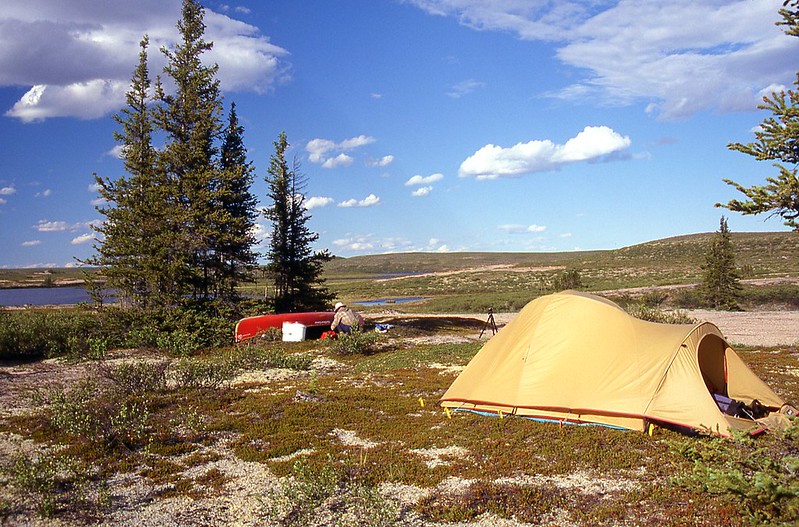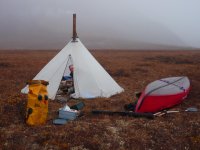There have been only two instances on all of our tripping that a bear actually came into our camp. Both situations were where there had been previous long-term or permanent camps. The following snippet is from where we were camped near a recent fire-suppression camp, where we were to be picked up by the float plane. There was lots of garbage spread around at the pick up. Not good, so we camped about 15 minutes away, at a cleaner location. I quote from my diary.
Yet again, another hot, sunny morning. Also, yet again, we relaxed over a slow fire and a bannock cooked slowly to the proverbial golden brown. We then started to pack, for the final time, and to load the canoe for the 15-minute paddle down Austin Lake to our pickup spot. I folded the tent and fly, rolled them up, and crammed them into the stuff-sack. We carried the canoe and all the smaller parcels and hand-held items down to the beach. I leaned my .308 rifle up against the canoe. We then returned for the three large canoe packs.
"Michael. There's a bear!"
I turned. Sure enough. A large (aren't approaching bears always large?) black bear was ambling toward the packs, striding right through the patch of Kinnikinnick where our tent had stood only moments ago. Together, Kathleen and I backed off slowly toward the beach and my .308 rifle leaning up against the canoe. The bear kept advancing, but not toward us. Kathleen and I stopped, stood together to appear larger and more formidable, and yelled out things that bears probably wouldn’t like to hear, such as “Hey bear.”
The bear didn’t seem to mind these harsh words too much, though, as he kept advancing and was now only 5 m (15 feet) from the canoe packs.
Kathleen and I have seen a lot of bears during our wilderness experiences. Well, it seems like a lot to us, anyway. I estimate about 200 black bears, 40 grizzly bears, and 5 polar bears. Other than the polar bears, this is the first bear that appeared unafraid and undeterred by our presence.
What to do? I preferred not to turn my back on the bear to walk about 30 m (100 feet) to get my .308 rifle leaning, somewhat inconveniently, up against the canoe on the beach. So we yelled some more. Probably said, “Hey bear,” again, with no visible effect whatsoever.
"Why don't you try your bear banger, Kathleen. Do you have it?"
"Yes. I almost packed it away, but I thought no, we're still in the wilderness. I better keep it with me."
My foresightful adventuring partner reached into her shirt pocket and pulled out the pen-sized launcher on which the explosive was screwed. She fumbled only slightly with the release mechanism and held the banger overhead.
The first small bang when the explosive launched produced no impact on the bear at all, who was now within sniffing distance of our three large packs of gear, clothing, food, (and toilet paper). Seconds later, the loud “bang” overhead caught the bear's attention. He looked over at us, and seemingly for the first time, noticed that we stood in the clearing.
He appeared confused, uncertain about his course of action. He looked at us again and then turned to walk away. After a few steps, he broke into a run and disappeared into the willows and spruce, heading along the shore, west, down the lake. It was good to know that the bear banger does actually work. At least sometimes.
We resumed packing, checking the periphery of our forest clearing with furtive inspections every few seconds. Minutes later, we paddled away onto a lake of glass beneath a warm, blue sky.


